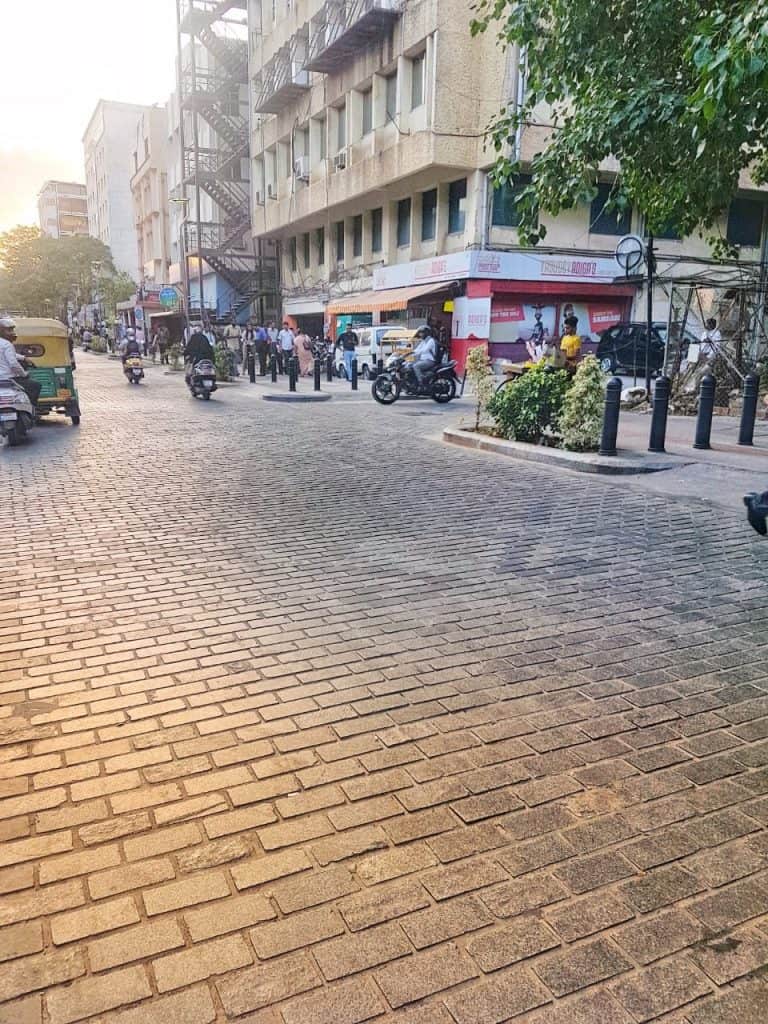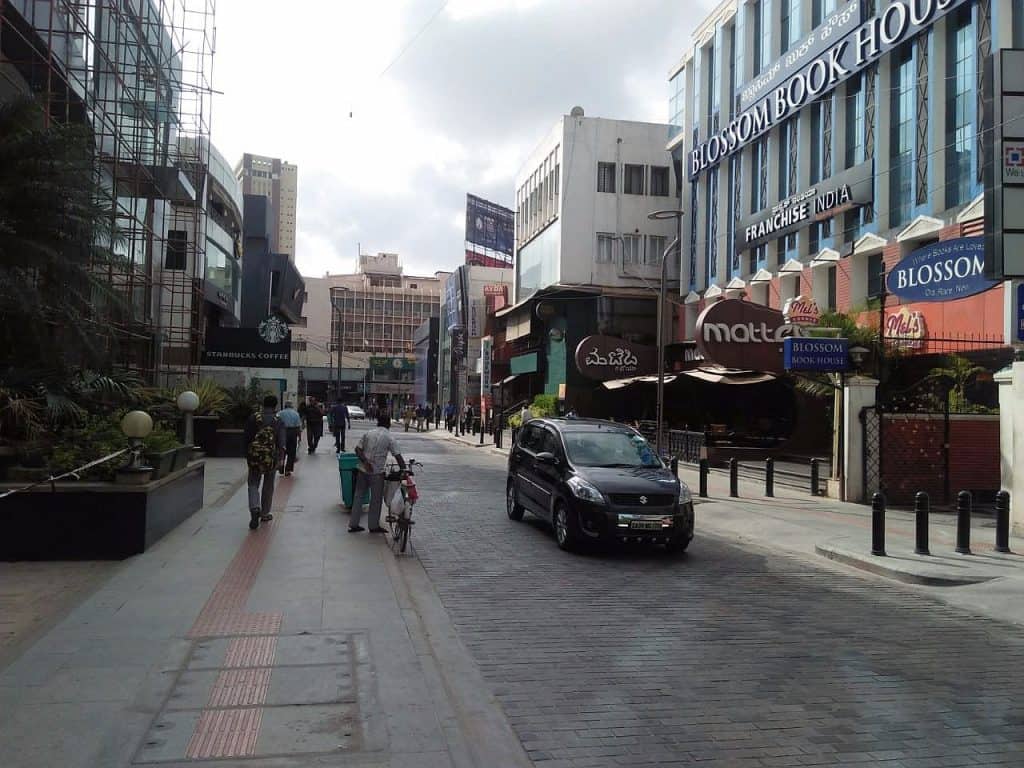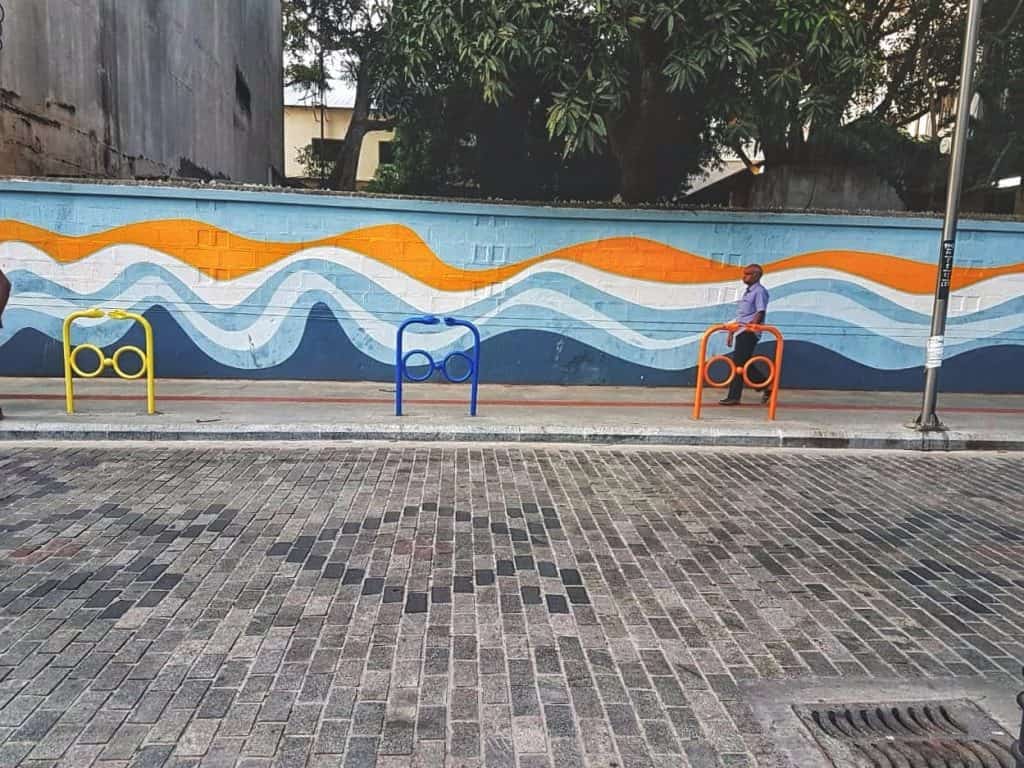
Church street was re-designed to be a pedestrian-friendly street. Pic: Shylaja Subrahmanya
The 712 meter stretch of Church Street which was opened to the public with much fanfare in March 2018 is back in the news. But this time it is not all good. Touted as the golden standard for pedestrian-centric roads, its fall from grace has been rather quick.
Reports of substandard construction and flooding during rains have been making regular appearance in various media outlets. The aspects of the roads which had garnered high praise, like using cobblestones for a road, innovative footpaths which are designed to be disabled-friendly are now being criticised for shoddy work and an impractical design.
The cost of the stretch which raised many an eyebrow during its making – a whopping Rs 11 crore had naturally also raised expectations of quality. So is it all that bad?
A quick inspection of the stretch points out to some obvious positives. Water logging which was a hallmark of Church Street is almost a thing of the past. Irfan Noor, Secretary, Church Street Occupants Association, says the drain holes that dot the stretch at every 30 meters do a great job of ensuring there is no flooding during the rains. The water drains out in a short period of time to the Rajakaluve instead of the sewage lines. Naresh Narasimhan of Venkatram Associates, the architect who designed the stretch also points out the stench that accompanied rains is now a thing of the past.
Indian Road Congress (IRC) standards followed
What about the engineering issues? Narasimhan agrees there are niggles that need to be ironed out. “Church Street caught the imagination of the people because of the unique kind of public space it has become. But like all engineering projects, there were some minor issues that have been set right.”
One of the concerns that was raised at the start of the project was that there were no standards set by the Indian Road Congress (IRC) for a cobblestone road that would be used as a motorable stretch. M Lokesh, Executive Engineer, Projects, BBMP which implemented the construction, says that is not the case.
According to him, the IRC has standards set for white topping, black topping and interlocking pavement blocks. For Black Topping roads or tar roads there are three layers – the granular sub-base or GSB, followed by the Wet Mix Macadam, the Dense Bitumen Macadam which is the strengthening layer, followed by the bitumen concrete which is the wearing course for the wear and tear of the road.
For white topping roads, the GSB and wet mix macadam remain constant followed by the dry lean concrete (DLC) and the pavement quality concrete (PQC).
For interlocking pavement blocks, the GSB and wet mix macadam is followed by the dry lean concrete and then a 50mm sand bed on which the interlocking tiles are placed.
In Church Street, Lokesh says BBMP has followed the IRC standards for interlocking pavement blocks. The GSB and wet mix macadam was followed by dry lean concrete and the granite cobble stones. The only thing which did not have prescribed standard was the topping. So what we did was have 75mm to 100mm granite slabs embedded in the stretch on which 100mm by 200mm cut stones were laid on the surface. We also left a gap of 10 to 15mm of the joints with a concrete bed of 50mm which they were placed in for the interlocking where they are allowed to bond and set. This is the first time we tried the concept.” he says.

Church street, Bengaluru. Pic: Shylaja Subrahmanya
The problem is in these joints which the official agrees to but also says they have been set right. “To argue that concept has failed because of a workmanship issue would be erroneous.” argues Lokesh.
Pedestrian-friendly street, but not pedestrian zone
However the IRC standards also discuss issues of rolling resistance (skid resistance) which speak to the safety of the road. Lokesh claims this too is better on the stretch. “For concrete roads we use a term M40 which basically speaks to the strength of the road in the context of anti skid. What it means is 40 newtons per millimeter grade of concrete strength on that road. In a granite road this is 100 newtons per millimetre grade of concrete strength. That is almost 2.5 times the strength of a regular road. There is no problem with the load bearing. It can take any amount of vehicular load.”
What both Naresh and Lokesh stress is that the road is not built for speeding and therefore there are regular placed signs on the stretch which have a 10 km speed limit. “I have been asking that the stretch be turned into a pedestrian zone and reduce the vehicular movement on it and reimagine the culture of the stretch” says Naresh.
However the BBMP has a different take on turning the pedestrian-friendly stretch into completely a pedestrian zone in a road that has more than 50 commercial establishments. “It is not possible. We can’t turn into a fully pedestrian zone. The issue is speeding vehicles on these joints that are the weak link which we need to address,” says Lokesh.
Road humps unsuitable for Church Street
One of the solutions used in addressing speeding are rumble strips or road humps. But, “when you have road humps, you observe that there is damage immediately before and after the hump because people slam their brakes to slow down. This would cause even more damage on a cobblestone stretch, so that’s not a good idea for Church Street,” reasons Lokesh.
Maintenance also seems to be a keyword. Does this stretch particularly need extra attention? “What we need (and this is true of every street in the city) is to maintain a high standard of hygiene and cleanliness. It will not suffice to have the stretch cleaned just once a day because of the sheer number of people who use it. It needs to be done multiple times a day. It should also be washed with water once a week and the treated sewage water from Cubbon Park can be used for it,” says Naresh. This became a contentious issue with people protesting against the privatisation of the road’s maintenance as they alleged it to be an exercise in losing common public assets to commercial interests.

There is a drainage hole after every 30 metres on the Church street, to carry the runoff water. Pic: Shylaja Subrahmanya
With more than 50 commercial establishments lining the stretch, delivery trucks also create a problem. One of contractors on the condition of anonymity told Citizen Matters: “The delivery guys drop full gas cylinders and beer kegs on the stones which will damage them. Another hacked off a cobblestone and took it home as a souvenir. We can do very little to change this attitude.” Lokesh agrees this is a problem. “This is just indiscipline.” Naresh calls it a lack of ownership for the stretch. The Occupants Association maintained they had no comments.
‘Do not write off the concept yet’
So how practical is it to have such engineering at the city centre which is a commercial hub and sees heavy vehicular movement? These roads cannot be made completely pedestrian because of the financial hit the commercial establishments would take. The maintenance requirements are beyond the capability of the BBMP, but the proposed privatisation sparks protests. There are engineering niggles that need to be sorted out and there are no prescribed standards set for this. So was it worth it to spend Rs 11 crores on 715 meter stretch?
“It is to early to write off the concept. We have to study it at least for a year and let one season go by before taking a judgement call on it. We still stand by our statement that this stretch will last for a longer duration. Since it is a new concept, we have to learn from a few mistakes. But it certain is a good idea” says Lokesh.